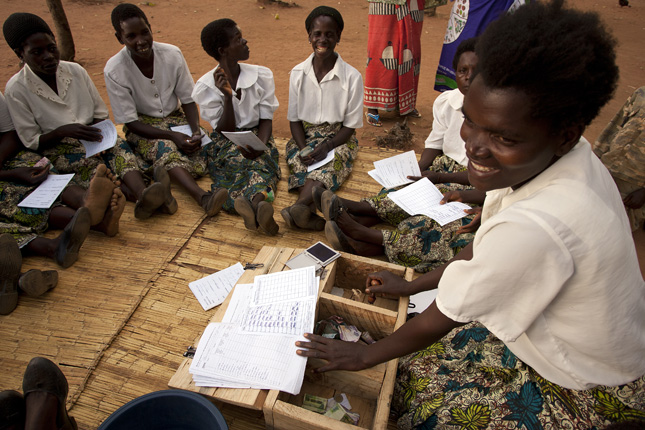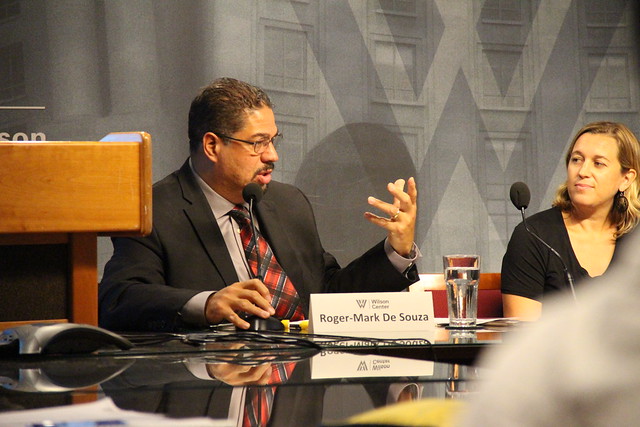-
Saving for a Rainless Day: Microfinancing for Resilience
August 16, 2017 By Yuval Cohen
“The sooner you save, the better off you’ll be in life, wherever you live, at whatever age you start,” said Sophie Romana, director of community finance at Oxfam America: “Saving is the key.” Microsavings groups—informal community-based financial pools–can help vulnerable communities build resilience, said representatives from support organizations CARE International, Oxfam America, and the Grameen Foundation at a Wilson Center event on June 29, 2017.
Microfinance initiatives like microsavings groups touch the lives of over 10 million individuals every day, most of whom live in sub-Saharan Africa. But the industry could reach many millions more who lack access to traditional forms of banking and finance. More than two and a half billion individuals worldwide, and about 76 percent of adults in Sub-Saharan Africa, do not have accounts with formal financial institutions.
What Are Microsavings?
Microsavings groups, supported by NGOs such as CARE/Pathways, reflect a global movement towards community-based development, in which individuals empower themselves and their communities through their own investments. Half of the adults in sub-Saharan Africa who actively save do so through informal community-based savings groups.
“We need to address the underlying causes of poverty and women’s exclusion from agriculture.”“For us to make meaningful changes,” said Salome Mhango from CARE Malawi, “we need to address the underlying causes of poverty and women’s exclusion from agriculture.” CARE International’s Village Savings & Loan Associations (VSLAs) and Oxfam America’s Saving for Change groups are focused on empowering women and their families through financial stability. Groups of mostly women save small amounts of their earnings every week to be pooled in a collective bank, which is later used to give loans out to members of the group who are in need. The returned interest is then typically invested back into their children and communities, or saved in case of emergencies.
The VSLA platform, for example, is implemented in local villages by community-based trainers, said Mhango, “who receive training, in not just Village Savings and Loans, but all the components that the program is focusing on, and they go and train the community.” This model could increase resilience in communities by building their capacity to respond to change in the future. The model is “anticipatory, absorptive, adaptive, and transformative,” she said.
“Resilience Is a Sexy Word, But How Do We Make It Practical?”
Microsavings provide the most vulnerable individuals with a financial buffer in the case of unexpected expenses, such as emergency medical costs. The Grameen Foundation works with Oxfam America in Mali, Benin, and Burkina Faso, said Cassie Chandler of the Grameen Foundation, through Saving for Change groups, which set aside a portion of their savings for health expenses, typically 25 percent of (their total) weekly savings, if they choose to do so.
In some countries, each woman may save as little as 15 cents a week. But over time the savings add up, producing a supply of cash that can be loaned to any member of the group for sudden medical costs. The average health loan is about nine dollars, with an interest rate set by the group members.
“After only one year of implementation, there were two thousand health loans already granted.”“After only one year of implementation, there were two thousand health loans already granted,” said Chandler. Almost half of the loans fund treatment for children’s illnesses, with more than 40 percent covering malaria treatment. The Grameen Foundation has received very positive feedback from women involved in these groups, who report that this financial safety net alleviates some of their anxiety.
Incorporating mechanisms for resilience into these programs, however, has been a challenge for supporting organizations. As Roger-Mark De Souza from the Wilson Center said, “Resilience is a sexy word, but how do we make it practical?”
There are promising examples: “In Cambodia, we’ve noticed that where there’s a Saving for Change group and there’s a flood, the village…will recover much faster,” said Romana. “In Senegal…we used savings groups to spread the WASH methodology to fight Ebola.”
But to be truly sustainable, savings groups must set specific goals around resilience, said Mhango, and incorporate risk management into planning, “including monitoring of risk factors and pre-agreed triggers to take actions when there is imminent danger to the cash.”
Combatting Delays and Distrust
Some of the greatest challenges come from too few preventative measures and a lack of appropriate health-related information and distrust, said Chandler: “One of the biggest [health-related] challenges was timely access to health services.”
Many of the women involved in Saving for Change groups in Benin, for example, reported having very negative experiences with their local health care facilities. They were often scolded for not preventing their children’s illnesses or not bringing them in sooner. In response, the Grameen Foundation created partnerships between local groups and 40 local health providers. In this system, women are able to communicate their needs and their experiences with the facilities, and the foundation discusses these concerns with the facility and its employees.
“The women said, ‘first and foremost, we want a friendly welcome,’” explained Chandler. The Grameen Foundation was also able to negotiate discounts on a number of services, in return for driving up demand to the local clinics. By building a bridge of communication, the program encouraged women to take their children to the clinic more frequently to prevent health crises.
Non-governmental organizations (NGOs) can support these savings groups, but resilience is in large part achieved when support organizations step back so that these groups may run independently. Facilitators check in on participants and assess their needs, but in many cases women will continue to innovate on their own long after the NGOs leave.
“A Sector That Thrives on Data”
“This is a sector that thrives on data,” said Romana, “and it is very creative.” The community must monitor the “effectiveness, low-cost services, sustainability, and failures” that exist in each program, so “Oxfam America dedicates at least seven percent of every program budget to evaluation, which includes randomized control trials.”
While quantitative measurements are crucial, Romana noted that qualitative data is sometimes the only way to truly understand the effectiveness of a specific program. In Mali, for example, where men often have multiple wives, appropriate data is necessary to understand the dynamics of the community—and whether or not a traditional microsavings group structure would work in such a situation.
There is positive evidence showing the impact of microsavingsThere are, however, a few gaps in available data. Some evidence shows increased economic empowerment for women—but to what degree exactly? How does microfinance influence children’s education and families’ incomes? What percentage of earnings do individuals really put into the collective savings?
But there is positive evidence showing the impact of microsavings: Savings groups build confidence and trust among members of the community, provide women with increased access to finance so they may gain status through purchasing land, and often last on their own years after the supporting organization has left. Microsavings have been proven to be sustainable and contagious—women who move out of the community will often create new savings groups wherever they go.
“This is such an elegant, simple, low-cost methodology. It should be used more widely,” said Romana.
“The fact that women organize in groups,” said Mhango, “creates solidarity and gives them the voice to be able to challenge the traditional beliefs, norms, and attitudes that normally work against women.”
Event Resources
- Cassie Chandler’s Presentation
- Salome Mhango’s Presentation
- Sophie Romana’s Presentation
- Event Video
- Photo Gallery
Sources: Care, Oxfam America
Photo Credit: Village savings and loan group in the Dowa district of central Malawi, March 2013, USAID/Feed the Children/Amos Gumulira
Topics: development, economics, featured, From the Wilson Center, gender, livelihoods, media, poverty, risk and resilience, video
 A Publication of the Stimson Center.
A Publication of the Stimson Center.




